When we think of exploring other planets and celestial bodies, we tend to focus on the big questions. How would astronauts live there when they're not working? What kind of strategies and technology would be needed for people to be there long term? How might the gravity, environment, and radiation effect humans who choose to make places like the Moon, Mars, and other bodies place their home? We tend to overlook the simple stuff...
For example, what will it be like to look up at the sky? How will Earth, the stars, and any moon in orbit appear? And how will it look to watch the sun go down? These are things we take for granted here on Earth and don't really ponder much. But thanks to NASA, we now have a tool that simulates what sunsets would look like from other bodies in the Solar System - from the hellish surface of Venus to the dense atmosphere of Uranus.
This simulation was created by Geronimo Villanueva, a planetary scientist from NASA's Goddard Space Flight Center who developed it while working on a computer modeling tool for possible missions to Uranus, which NASA is contemplating sending a probe to in the near future. If and when such a mission takes place, the probe would descend into Uranus' atmosphere and use this tool to obtain spectra and determine its composition.
As you can see, Villaneuva's simulation compares how a sunset would look on various worlds using Earth as the "control group," both during a clear night and when the sky is hazy. A Uranian sunset, in contrast, appears as a rich azure glow in the sky which gradually becomes a deep blue as the sun sinks to the horizon. This color is caused by the interaction of sunlight with Uranus' atmosphere, which is rich in hydrogen, helium, and methane.
These gases absorb the longer-wavelengths of the spectrum (red, orange, and yellow) and shorter-wavelength photons (blue and green) to scatter and collide with other molecules in the atmosphere. This is similar to what happens in Earth's atmosphere on a clear day, where light is scattered when interacting with our atmosphere. When this happens, shorter-wavelength blue photons are scattered more, causing the sky to appear blue.
Meanwhile, a sunset Venus (a Cytherean sunset!) appears as a hazy yellow, that gradually turning into a deep brown as the Sun sinks to the horizon. This is the result of sunlight having a difficult time piercing Venus' extremely dense and toxic atmosphere, which is composed predominantly of carbon dioxide with traces of nitrogen and other gases.
Mars experiences something similar, with hazy grey-brown skies and an intense glow as it reaches the horizon. If you look closely, you'll also see how the Sun appears blue just before it sinks beneath the horizon. This is a familiar sight for followers of the Opportunity and subsequent rover missions, which have witnessed a blue sunset on Mars on more than one occasion.
Lastly, there's Titan, where the atmosphere appears a deep and hazy orange (exactly as it appears from space) which turns into a deep brown as the sun sinks toward the horizon. This color and hazy appearance are due to Titan's unusual atmosphere, which is predominantly composed of nitrogen (95%) and contains high concentrations of methane and other carbon-rich organic molecules.
To validate the accuracy of this tool, Villanueva simulated known sky colors of Uranus and other worlds. The animations show all-sky views that mimick what it would be like to look up from the surface of another body using a super-wide lens. The halos of light that appear in some cases towards the end are produced by the way light is scattered by particles, including dust or fog, that are suspended certain in atmospheres.
These simulations are now part of the Planetary Spectrum Generator, a popular online tool developed by Villaneuva and his colleagues at NASA Goddard (which was used to produce the animation below). This generator allows scientists to replicate how light is scattered through the atmospheres of planets, moons, comets, and even exoplanets which allows them to gauge their compositions.
But for the rest of us, it serves to illustrate what it might look like to look up from an alien landscape. The world may be strange and its skies a different color, but what is there is still familiar to us.
*Further Reading: NASA*
 Universe Today
Universe Today

